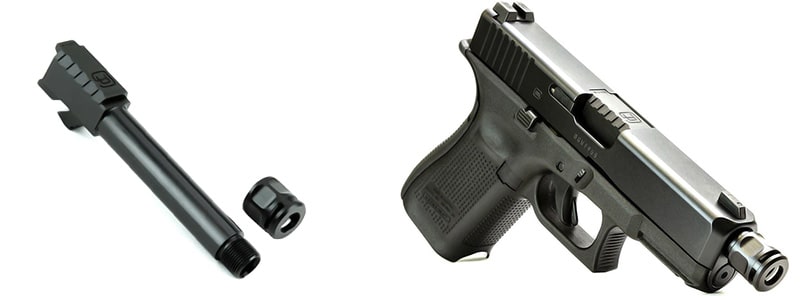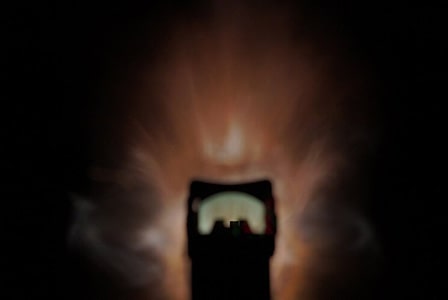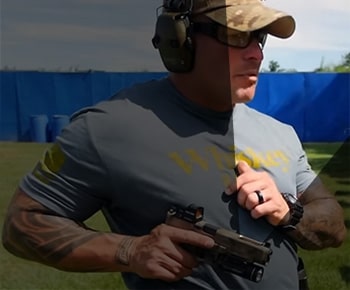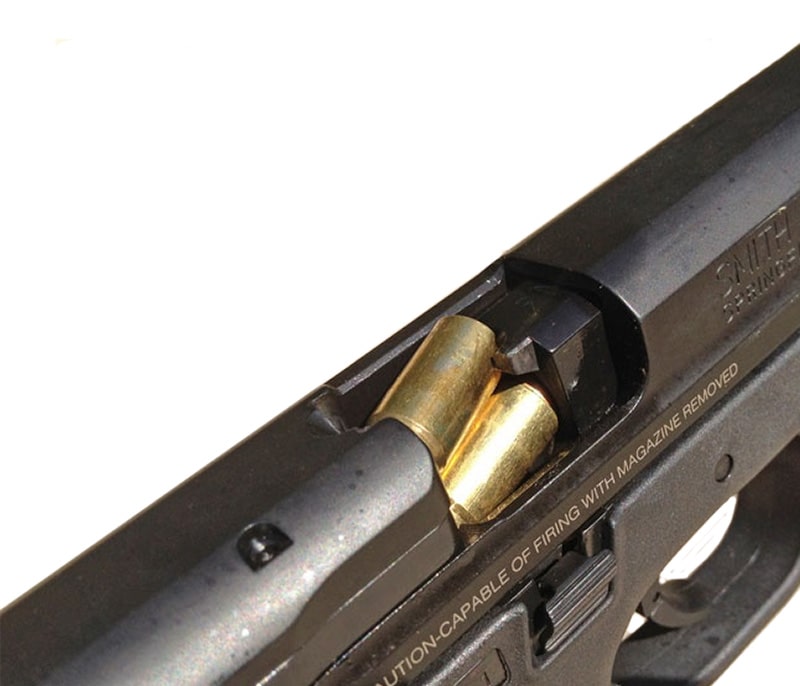Pistol Compensators: The Ultimate Guide
 Bryan Hill / March 21 2024
Bryan Hill / March 21 2024

Ever wanted to reduce recoil in your pistol? A compensator is the best upgrade.
We'll cover:
-
How to max out your benefits from a pistol compensator without the drawbacks
-
Address myths and misinformation with real video examples.
On this Page:
- How Does a Pistol Compensator Work?
- Pistol Compensator Myths
- Are Pistol Compensators Worth It?
- How to Prevent Jams in Compensated Pistols
- 3 Best Pistol Compensators [2024]
- References
How Does a Pistol Compensator Work?
Pistol compensators mount onto a threaded barrel.
When you fire a pistol, gasses push the bullet out the barrel.
As the bullet exits the muzzle, a compensator vents those gasses up.
The equal and opposite reaction pushes your muzzle down.
The more ports, and the bigger the ports, the more gas pushes up.
That pushes your pistol's muzzle down.
Rifle muzzle brakes work the same way, but also push the rifle forward. That reduces backward recoil:
Pistol Compensator Myths
Myth: Pistol Compensators Blind You at Night
In moonlight or darker, you can get disoriented by extra flash from the compensator.
But that's only true when only if your target isn't lit up.
Can you ID any targets in this picture?

If it's too dark to ID your target, don't shoot.
Anytime a compensator would disorient you, you'd be firing on something you can't ID.
If you use a flashlight or pistol light on your target, a compensator's flash will not disorient you.
Myth: Pistol Compensators Cause Jams
This is only true if you use a pistol compensator that's too large or heavy.
Today there are pistol compensators made for reliability over performance.
You'll have less recoil reduction, but won't have jams. A good trade.
A pistol compensator generally doesn't cause jams if it:
-
Reduces recoil by 30% or less
-
Weighs 0.60 oz. or less
-
Has a description like, "made for stock/OEM recoil assembly"
We only recommend such compensators.
We still have you covered with a guide on preventing jams in compensated pistols at the end of this article.
Myth: Pistol Compensator Gasses Will Blind You
For a pistol compensator's gasses to damage your eyes, your eyeballs would have to be right at the muzzle.
They'd get smacked by the pistol recoiling.
That said, if you hold your pistol too close, the gasses vented up by the compensator can spray into your face.

It's uncomfortable. It feels like hot sand thrown in your face. If you're not wearing eye protection, this can disorient you for a moment.
What if you're out concealed carrying? Most people don't walk around wearing eyepro. Here's an option:
Turn your firing hand's palm 45º out when firing from retention.
It's like turning a door knob. The gasses go away from your face, and you can't use your sights anyway in retention. Practice it.
Are Pistol Compensators Worth It?
Pros
-
25-45% less recoil for faster accurate shots.
And unlike ported barrels, compensators don't reduce the power of your shots.
-
Same recoil with more powerful ammo.
Normally, +P or +P+ ammo increases recoil 10% or more.
With a compenstator, the recoil stays the same. Why? The more powerful your ammo, the harder the compensator works.
-
Better Red Dot Optic tracking.
If a pistol recoils too much, you'll lose sight of your optic's dot for a moment each time you fire.
Some find this jarring.
With a compensator and good grip technique, you can track the dot the whole time you're in recoil.
Cons
- Practicing/training indoors can suck.
You will feel sick if you breathe in a pistol compensator's gasses during:
-
Extended practice indoors
-
Training retention shooting
-
Shooting from retentioncan be uncomfortable, but there are a few ways around it.
You can wear eye protection, or you can rotate your shooting hand palm out 45º.
-
More noise for the shooter.
The redirected gasses bring noise closer to your ears.
It's a few decibels (dB) for a pistol.
-
Extra length.
A threaded barrel and compensator adds 0.75-2 inches to the gun.
Pocket pistols may not stay pocket-sized with a pistol compensator.
A compact pistol becomes as long as a full-size pistol.
-
Cost ($60-350).
A pistol compensator is $60-150. If you don't already have a threaded barrel, that's another $100-200.
The Verdict
Compensators have some drawbacks, but they're an awesome fit for:
-
Competition (2+ port comp, full-size pistol).
-
Home defense (1-2 port comp, full-size or compact pistol).
-
Duty carry (1-2 port comp, compact pistol).
-
Concealed carry (compact or pocket pistol with a micro or 1-port comp).
Test a compensated pistol at the range.
Ensure the compensator doesn't come loose and that it doesn't cause jams.
How to Prevent Jams in Compensated Pistols

Any pistol modification that reduces recoil can cause jams, and jams in a real gunfight are fatal.
Why does reducing recoil affect reliability?
In semiauto pistols, recoil is what reloads the gun.
Softening recoil slows that reloading process. If it gets too slow, the timing of the system gets screwed up and you get jams.
How do we ensure reliability?
Many recommend shooting your modified pistol at least 1,000 times with no jams.
To save time and money, here's a way to test reliability with 100 or fewer rounds.
-
Find your pistol's stock recoil spring weight. It's typically 13-20 lbs.
-
Order 3 recoil springs: one 3 lbs., 4 lbs., and 6 lbs. lighter.
If it's a Glock, get the spring 3 lbs. lighter.
If you go any lighter on a Glock, you'll need a lighter, longer striker spring, too.
-
Ensure you have medium and heavy-weight ammo for range practice.
| Ammo Weight |
Light |
Medium |
Heavy |
| .380 |
90gr |
95gr |
102gr |
| 9mm |
115gr |
124gr |
147gr |
| 10mm |
155gr |
180gr |
200gr |
-
Ensure you have 10-20 rounds of extra defensive ammo on hand.
-
Prepare for a range trip. Pack your:
-
Stock pistol
-
Threaded barrel
-
Compensator
-
Recoil springs
-
Range ammo
-
Defensive ammo
-
Go to an outdoor range. Get on the firing line and load your stock pistol with medium-weight range ammo.
-
Present your pistol. Get a sight picture on the target.
While keeping your gun aimed downrange, look 6-8 ft to the right of your gun.
You're going to track the casing of your shots instead of where your bullets hit.
-
Hold your pistol with two hands and use proper grip technique.
Fire one round. Look for the path of the casing. It should eject 6-8 ft away.
-
Fire one round at a time until you can get a good sense of where the spent brass lands. If you're having trouble, have someone stand behind you and watch where it lands.
-
Record the distance where the brass lands and its path.
-
Unload your pistol. Install the compensator.
-
Load your pistol. Repeat the process of firing your pistol and recording where the spent casing lands.
-
Record the new distance where the brass lands and its path.
-
If the casings land less than 6-8 ft away, unload your pistol and install a lighter recoil spring.
Reducing the spring weight by 1 lb adds 1.5-2.0 ft of ejection. So if you need 3-4 more ft of ejection, try a spring 2 lb lighter.
-
If your lightest recoil spring doesn't give 6-8 ft of ejection distance, try different ammo. First try heavier bullet weights, then try +P and +P+ ammo (if your pistol is rated for it).
If you couldn't find a setup that worked for you, here are your options:
-
Use a smaller comp with fewer ports. Some micro-comps work with the stock recoil spring, but reduce recoil by 25-30% instead of 40-45%.
-
Have a gunsmith lighten your slide by 1-2 oz. to increase reliability with a compensator ($100-200).
Each time you make a change, record your ejection distance. It must be 6-8 ft to be reliable.
3 Best Pistol Compensators [2024]
The best compensators have these features:
-
Lightweight. Most semiauto pistols must lift the barrel as part of slide movement.
The heavier the comp, the more you have to tune recoil springs to prevent jams for the same performance.
-
No longer than needed. When carrying, a shorter comp is better.
-
Side ports, angled correctly. Side ports help stability in recoil when your grip isn't perfect.
They also cut down total recoil.
When these ports are shaped to move gasses diagonally towards you, it works like a muzzle brake.
That cuts recoil even more.
You may need to tune your recoil springs to keep it reliable.
Side ports with no angling can be best when you can't tune your recoil spring.
Total area of the side ports should be no larger than 75% of the top ports.
- Best Pistol Compensator for Concealed Carry
- Best Pistol Compensator for Home Defense
Best Pistol Compensator for Concealed Carry
Easiest to Carry: Griffin Armament Micro Carry Comp
The Griffin Armament Micro Carry Comp is the best compensator for concealed carry. Why?
-
Compatible with nearly every 9mm pistol (with a threaded barrel)
-
No recoil spring tuning needed
-
Most comfortable to conceal carry
-
Best holster compatibility
What's the catch? Recoil reduction of 20%.
Other compensators reduce recoil by 35% or even 40%.
But those are larger. They may not work as well for carry.
You'll also have to test out recoil springs and ammo to prevent jams.
If you have a threaded barrel on a carry pistol, you might as well replace its thread protector with a Micro Comp.
Best Deal Guarantee
Updated hourly
|
|
Griffin Armament Micro Carry Comp
$61.00
$59.95
@ 
Compare Prices
|
Griffin Armament Micro Carry Comp (G42/43, Sig p365)
$61.00
@ 
Compare Prices
|
| Recoil Reduction |
20% (more with +P or +P+ ammo) |
20% (more with +P or +P+ ammo) |
|
0.50oz |
0.50oz |
|
0.7" |
0.7" |
| Threads |
1/2x28 |
1/2x28 |
|
Any except Glock 42, Glock 43, or Sig p365 |
Glock 42, Glock 43, Sig p365 |
|
-
Great holster compatibilty.
-
Has nearly the same footprint as a thread protector - adds just 0.25" of length.
-
Works with OEM recoil spring. No tuning required, though dropping the spring weight by 2-4 lb. will work if you want the slide to be easier to rack.
-
Needs to be torqued on with a wrench to stay on while shooting (8+ ft/lbs., 16mm wrench). Also consider using Loctite 272 for a more secure fit.
-
Has ports at 12:00, 4:00, and 8:00. The 4:00 and 8:00 ports might dirty up a light or laser if the ports are right in front of it.
|
-
As the Griffin Armament Micro Carry Comp, but tweaked for pocket pistols.
|
Best Pistol Compensator for Home Defense
Best Performance: ZEV Technologies PRO V2 9mm
The ZEV Technologies PRO V2 9mm has great performance due to how its side ports are shaped.
The gasses don't go straight out the sides.
They go towards you like a rifle muzzle brake.
The gasses push the gun away from you, cutting recoil more than similar comps.
The downsides vs. carry comps are:
-
A trickier install.
-
Takes more tuning to get it reliable (I recommend a 4 lb. lighter than OEM recoil spring).
-
Harder to carry due to longer length.
Carry and Home Defense: Legion Precision 9mm Compensator
The top contender is the Legion Precision 9mm Compensator.
Its ports aren't beveled in a way that maxes out performance, and it doesn't have side ports to stabilize the gun.
So why buy it?
It's 0.28" shorter than the ZEV. That may not sound like much...But when carrying?
It can be the difference in your gun digging into you when carrying appendix.
It also takes less tuning to get it to run jam-free because it's lighter and has less ported area.
I recommend a 2 lb. lighter recoil spring.
You can get away with the OEM recoil spring for defensive use if you use +P defensive ammo.
Which is Best for Me?
Do you want a dedicated home defense pistol that needs some tuning?
Or something you can both carry and use for home defense?
Can you get lighter aftermarket recoil springs for your pistol?
The answers decide which is your best handgun compensator for home defense.
Best Deal Guarantee
Updated hourly
|
|
Legion Precision 9mm Compensator
$79.99
@ Legion Precision
|
ZEV Technologies PRO V2 9mm
Compare Prices
|
| Recoil Reduction |
35% (more with +P or +P+ ammo) |
40% (more with +P or +P+ ammo) |
|
0.65oz |
1oz |
|
1.2" |
1.48" |
| Threads |
1/2x28 |
1/2x28 |
|
Any |
Most 9mm pistols (though advertised for Glock) |
|
-
Good recoil reduction.
-
Lightweight and short for its type.
-
Requires tuning recoil spring weights, despite being advertised as working with OEM recoil springs. Change your recoil spring to at least 2 lbs. lighter than OEM, or use +P ammo to ensure a reliable 6-8 ft. of ejection.
-
Adds 0.73" of length to your threaded pistol, changing a threaded compact pistol (like a Glock 19) into the length of a full-size pistol (like a Glock 34). Your pistol may need a new holster, or become uncomfortable to carry.
-
Uses set screws for install. Can damage your barrel threads if done improperly. Consider Loctite 272 for a more secure fit.
-
No side ports.
|
-
High recoil reduction.
-
Side ports stabilize the gun left-to-right in recoil.
-
Requires tuning recoil spring weights, despite being advertised as working with OEM recoil springs. Change your recoil spring to at least 4 lbs. lighter than OEM to ensure a reliable 6-8 ft. of ejection.
-
Adds 1" of length to your threaded pistol, changing a threaded compact pistol (like a Glock 19) into the length of a full-size pistol (like a Glock 34). Your pistol may need a new holster, or become uncomfortable to carry.
-
Uses set screws for install. Can damage your barrel threads if done improperly. Consider Loctite 272 for a more secure fit.
-
Ports at 3:00 and 9:00 add performance for you, but can annoy adjacent people at a shooting range or training class.
|
Disclaimer: I get a small commission on purchases through the price links above, at no extra cost to you.
Related Articles
Feedback
Are you happy with this page?
References
-
Pistol Compensator: Clash of the Carry Comp (2021)
-
How to Select the Proper Recoil Spring (2019)
-
2018 King of Pistol Comps – Glock Compensator Review (2018)
-
Compensated and Ported Handguns in Low Light (2018)
-
How Compensators Help You Shoot Faster (2017)
-
Compensated Handguns (2017)
-
Tuning your Pistol for Faster Double Taps with Recoil Springs (2017)
-
Pistol Recoil Reduction: Ports vs. Compensator (2015)
-
Mag-na-port Gun Recoil Reduction- review and high speed comparisons with Jerry Miculek (2013)
-
GAN'S ENTERPRISE CUSTOM 2011 WORK (2011)
-
How does a comp affect ejection (2011)
-
Physics of a Compensator (2009)